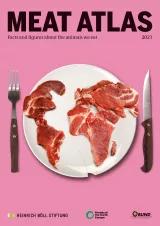
Antibiotics help to treat many diseases. The big problem: in both humans and animals, pathogens can develop antibiotic resistance – a fatal danger. And in industrial livestock production, these drugs are still not being used carefully enough.

The global Covid-19 crisis has shown how dangerous it can be if there is a lack of effective medicines to treat people with diseases. Another global health crisis, one that already kills 700,000 people a year, is caused by bacteria that are resistant to antibiotics. The effectiveness of these medicines is limited because they are overused or wrongly applied, and the germs have become resistant to them. The World Health Organization has for years been warning of the spread of resistant strains of pathogens.
A large part of the problem is that 73 percent of the antibiotics sold worldwide are used on animals, not to treat illness in humans. The proportion of industrial animal agriculture that routinely uses antibiotics is rising. Market analyses for pharmaceutical companies reveal that the global market for veterinary medicines has risen by 5 to 6 percent per year in recent years. If governments do not step in to regulate this more strictly, researchers predict a 67 percent increase in antibiotic use for livestock between 2010 and 2030.
Bacteria are constantly adapting. They develop genes for resistance, and they can pass these on to other bacteria, even from one species to another. That is especially a problem for zoonoses – pathogens that can infect both animals and humans – which can transfer resistance from the animal kingdom into the human body.
Resistance in livestock farms has increased markedly since the turn of the millennium in many countries. Parts of China and India are currently in the lead, but the numbers in Brazil and Kenya are also rising quickly. The World Health Organization warns that the excessive and inappropriate use of antibiotics in livestock is increasingly threatening their effectiveness in humans. That is because in animal husbandry, the bacteria develop resistance against the same antibiotics that are routinely used to treat infectious diseases in humans.
The use of so-called Highest Priority Critically Important Antibiotics (HP-CIAs) poses special problems. The World Health Organization recommends that these emergency antibiotics should be reserved for use in humans for cases where other antibiotics are ineffective. Although the EU Parliament has been calling for stricter rules for the application of HP-CIAs in stables for years, the EU Commission has not yet effectively regulated their use.
According to a study by the non-governmental organization Germanwatch, antibiotic-resistant pathogens were found in 51 percent of chicken samples from major poultry producers in five EU countries. Some 35 percent of the laboratory samples even had pathogens that were resistant to HP-CIAs and which could therefore render these last-ditch remedies ineffective. Meat from the poultry industry drags the resistant pathogens into the food chain, and therefore into consumers’ kitchens. Humans could pick up the multiresistant pathogens while preparing or eating contaminated meat. The resistant microbes may cause severe infections, against which hardly any antibiotics are effective. Or the genes that cause resistance can remain in the person’s gut and render the medications used to treat other infections ineffective.
Livestock farms and abattoir employees, veterinarians, and residents of areas with large numbers of animals are affected by resistant pathogens especially often. The risk of contracting these pathogens is 100 times higher for people who work in livestock enclosures than for people in nearby areas who have no contact to animals. The Covid-19 crisis has revealed the miserable working conditions for staff in many abattoirs. On top of that are the above-average health risks these workers face as a result of resistant pathogens.
Since 2007, no new class of antibiotics against infections in humans and animals has come onto the market. So there are no new mechanisms of action, and no new active substances. On the contrary: the patent protection for many antibiotics has expired, and the drugs are cheaply available. From a business point of view, it is worthwhile to research and produce new antibiotics only if they are used as often as possible. The logic of the market therefore contradicts the goal of maintaining the effectiveness of available treatments for as long as feasible so they can be used only in emergencies.
Antibiotics reduce the costs of livestock production in many ways. They can compensate for shortcomings in hygiene, management and care of the animals in the short term, yet account for only one to three percent of the total production costs. Some countries, including Brazil, permit their use to improve performance. The treated animals make better use of their feed and gain weight more quickly. This is forbidden in the European Union. Human and veterinary doctors, consumer groups and environmental protection organizations around the world are calling for better laws to protect animals, a ban on the use of HP-CIAs in livestock, and high levies on other antibiotics, so that animal welfare that uses as few antibiotics as possible becomes more attractive to the farming industry.


